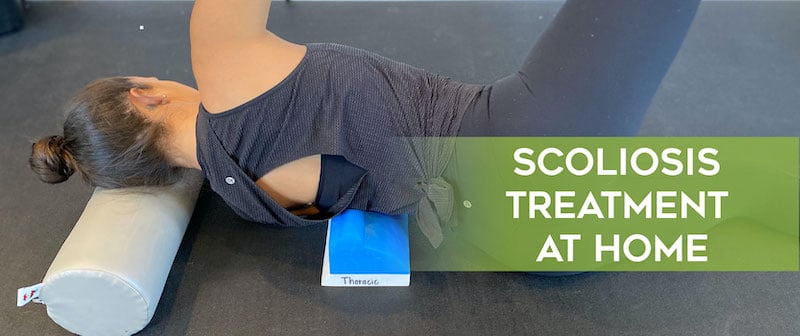
Many patients who are diagnosed with scoliosis may wonder about scoliosis treatment at home. Is it possible? Is it something I could try? What can I do at home to help my scoliosis? Because scoliosis is a complex progressive condition of the spine, patients should not attempt scoliosis treatment at home without the direction of a scoliosis-specific medical professional. As a scoliosis-specific chiropractor, I prescribe exercises that, when combined with in-office care, can enhance and compliment curve correction.
Before we talk about these custom prescribed exercises, let’s talk a little bit about what, in general, anyone diagnosed with scoliosis can do. Keep in mind that these recommendations are not a way to manage scoliosis. There is no replacement for a custom prescribed home exercise program.
One of the most important things individuals with scoliosis can do is be mindful of their position and posture. Sitting properly is important for everyone, but it is especially important for individuals with scoliosis.
Since people with scoliosis should be mindful of position, they should ask themselves, “Am I sitting more on one side versus the other?”
Most patients in general have developed poor posture habits, especially while sitting. I find that a lot of my female patients tend to have a habit of sitting on one foot. They put their foot under their butt, and this slants their entire body one direction.
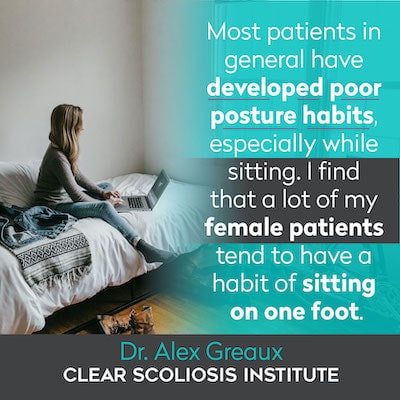
If they have a lumbar scoliosis curve, they tend to sit on the side that drives their spine into even more of a curve. While this may not seem like a big deal, this can accelerate the curve dramatically if sitting on their foot is a habit and repeated time and time again.
The goal in being mindful of position is to try to decrease anything that is going to proliferate or accelerate the curve. It is constantly being aware of one’s posture and position, while recognizing that this is not a way to manage scoliosis or a substitute for corrective exercises.
When it comes to neck position, I always talk about texting, constantly looking down at one’s phone, and being on a computer. Most people have heard, by now, the statistic stating that when the head is an inch forward, it equals an additional 10 pounds of weight.
I am very realistic in my approach to the position of the neck. I understand that people are going to be reading, studying, texting, and on the computer. If someone can be aware of that and do everything in their power to maintain a position where their head is neutral and not always looking down, it will only benefit your health and body. This goes for everyone, not just individuals with scoliosis.
Another issue I see with position is sleeping. Sleeping on your stomach is the worst position to sleep in. This essentially changes the entire biomechanics of your spine.
If you think about the biomechanics of the spine, it should be straight from the front and have three curves from the side.
When someone sleeps on their stomach, they have to turn their head and neck to the side to breathe. This forces an abnormal angle into the neck. In the lower back, the prone position causes abnormal movement in the joints of the back which affects the normal pattern of range of motion. This is like jamming a joint and limiting the movement. 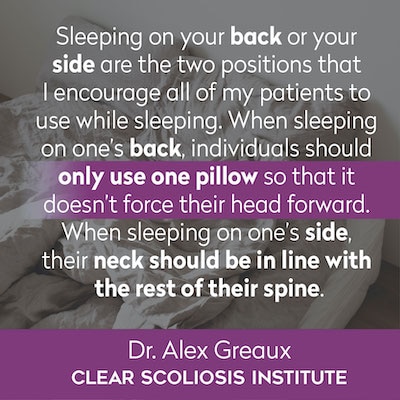
Sleeping on your back or your side are the two positions that I encourage all of my patients to use while sleeping. When sleeping on one’s back, individuals should only use one pillow so that it doesn’t force their head forward. When sleeping on one’s side, their neck should be in line with the rest of their spine. A pillow that is too small or too large will cause the neck to bend into an abnormal position.
When it comes to moving your body, in general movement is better than not moving. I would say this for any patient, not just a scoliosis patient, because when someone is moving, they are putting movement into their spine. A moving spine is always a healthier spine.
Inherently, if a curve is going to grow, the curve is going to grow regardless of what exercises a patient does. Treating a progressive condition like scoliosis is about being proactive and minimizing bad posture and position to give someone the best fighting chance - keeping the condition from progressing and getting worse.
CLEAR-certified doctors worldwide know there is a better way to treat scoliosis than the traditional watch and wait method.
CLEAR-certified chiropractors offer patients a natural, non-invasive approach to offer patients that combines in-office care and home rehabilitation. By prescribing very specific exercises, we are able to retrain the brain to improve posture and position, therefore improving the opportunity for curve correction.
Over time, performing these different positional exercises will effectively help change the patient’s curve long-term.
When these custom prescribed exercises are implemented into a daily routine, they provide an effective way to manage scoliosis at home. The patients I see who achieve the highest level of curve correction do their exercises on a regular basis.
Most of my scoliosis patients spend about an hour throughout the day doing their exercises. Some may spend a little more time, and some may spend a little less time. It is different for everyone, depending on their case.
Getting the exercises done is really just like any other habit; they simply need to be incorporated into the patient’s daily routine.
For some of my scoliosis patients, their exercises are the only component of care that needs to be done at home. Other patients are prescribed a corrective brace, such as the ScoliBrace, or weights and cantilever-like devices. Cantilevers are positioned on the body to help improve how a person with scoliosis will balance and react to gravity.
When used in combination, chiropractic, therapy, rehabilitation, and corrective bracing all work together to reduce the curve and give a patient their best fighting chance to not progress, or even to improve, their degree of curvature.
At South Florida Scoliosis Center, we are realistic in our approach. We understand that patients have school, work, and other activities. The exercises we prescribe are what we consider to be ‘the most bang for your buck' exercises. In other words, what we prescribe for an individual patient is based on what is most beneficial for their scoliosis case and their lifestyle.
In a typical case with a 14-year-old girl diagnosed with moderate scoliosis, if she is in school all day and has swimming and gymnastics at night, we are going to be realistic with her. Her life is busy, we will come up with a specific customized plan and tell her, "You need to do this in the morning during your typical morning routine, do this after school before swimming and gymnastics, and do this at night".
We will design something that works for her. This way, we come up with a specific customized routine for each patient so that we can help each patient with their individual condition, based on how their lifestyle impacts their schedule. 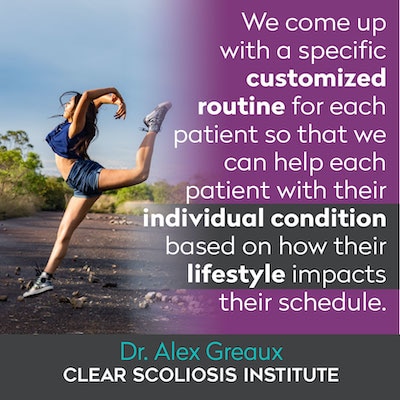
Even though all of the patients I work with at South Florida Scoliosis Center have scoliosis, there are so many unique components and variables for each scoliosis case that every patient needs to have their own individual routine specifically designed for their curve.
While many patients wonder about the possibility of scoliosis treatment at home, it should never be attempted without the direction of a scoliosis-specific trained medical professional.
There are, however, general recommendations that patients with scoliosis can be mindful of in an attempt to slow the progression of their scoliosis. The first is being mindful of position. Scoliosis patients should avoid sitting on their foot and staring down at a phone or computer screen all day. Being mindful of position and paying close attention to posture is good for everyone, not simply individuals with scoliosis.
Scoliosis patients should also try to be mindful of how they sleep - trying to sleep on their back or side, as these positions allow for the most natural alignment of the spine.
As mentioned earlier, exercises that help facilitate scoliosis treatment at home should only be done under the supervision of a scoliosis-specific medical professional. A CLEAR-certified doctor at a CLEAR Scoliosis Center is an excellent place to start.
For patients wanting to do a portion of their scoliosis treatment at home, I highly recommend visiting a CLEAR-certified doctor to see if there are exercises they can do in the comfort of their own home that will compliment in-office treatment. Our custom designed home exercises are frequently mentioned as one of the greatest benefits to the CLEAR approach.
Clear-institute.org - A Typical Treatment Session
Clear-institute.org - Weight-Bearing Exercises and Scoliosis
South Florida Scoliosis Center - What to Do in the Event of a Positive Diagnosis
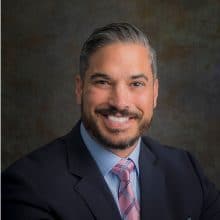
CLEAR provides a unique and innovative way of understanding scoliosis. Sign up to receive facts and information you won’t find anywhere else.

I liked the article - well written and fair. Good advice for the parents of an adolescent with scoliosis, and for adults too!